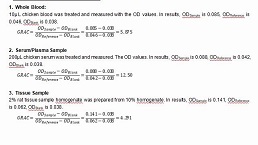Glutathione Reductase Activity Coefficient Assay Kit
Instruction manual
First Edition (Revised on April, 2016)
[ INTENDED USE ]
The kit applies to measure Glutathione Reductase Activity Coefficient (GRAC) in whole blood, serum/plasma, tissue etc.. The GRAC may be used to evaluate the nutrition level of riboflavin in vivo.
[ REAGENTS AND MATERIALS PROVIDED ]
Reagents | Quantity(100T/48 Samples) | Reagents | Quantity(100T/48 Samples) |
Reagent I | 1×32mL | Reagent IV | 2 |
Reagent II | 1×0.22mL | Reagent IV Diluent | 2×1.3mL |
Reagent II Diluent | 1×2.2mL | Reagent V | 2×40mL |
Reagent III | 2 | Reagent VI | 2 |
Reagent III Diluent | 2×2.5mL | Reagent VI Diluent | 2×50mL |
Instruction manual | 1 |
[ MATERIALS REQUIRED BUT NOT SUPPLIED ]
1. A spectrophotometer capable of measuring absorbance at 420nm, glass cuvettes of 12.5px light path.
2. Desk centrifuge.
3. Transferpettor and tips.
4. Vortex mixer.
5. A source of pure water (preferably double distilled water and double distilled water).
[ STORAGE OF THE KITS ]
Reagent I: Solution. Preserved at 4°C for 3 months.
Reagent II: Solution. Preserved at -20°C without light struck for 3 months.
Reagent II Diluent: Solution. Preserved at -20°C for 3 months.
Reagent III: Powder. Preserved at -20°C without light struck for 3 months.
Reagent III Diluent: Solution. Preserved at -20°C for 3 months.
Reagent IV: Powder. Preserved at -20°C without light struck for 3 months.
Reagent IV Diluent: Solution. Preserved at -20°C for 3 months.
Reagent V: Solution. Preserved at 4°C for 3 months.
Reagent VI: Powder. Preserved at 4°C without light struck for 3 months.
Reagent VI Diluent: Solution. Preserved at 4°C without light struck for 3 months.
[ REAGENT PREPARATION ]
1. Reagent II Standard preparation: Dilute the Reagent II with Reagent II diluent to 10 times of its initial volume. The excess amount can be preserved at 4°C for 3 days or at -20°C for longer period.
2. Reagent III Solution preparation: Dissolve one bottle of Reagent III with one bottle of Reagent III diluent and mix till fully dissolve. The excess amount can be preserved at 4°C for 3 days or at -20°C for longer period.
3. Reagent IV Solution preparation: Dissolve one bottle of Reagent IV with one bottle of Reagent IV diluent and mix till fully dissolve. The excess amount can be preserved at 4°C for 3 days or at -20°C for longer period.
4. Reagent VI Solution preparation: Dissolve one bottle of Reagent VI with one bottle of Reagent VI diluent and mix till fully dissolve. The excess amount can be preserved at 4°C without light struck.
[ SAMPLE PREPARATION ]
1. Whole Blood:
Extract 10μL whole blood sample to 990μl DDW. Vortex for 1 min to give hemolysate solution.
2. Serum/Plasma:
Dilute 200μL serum sample with 600μL physiological saline.
3. Tissue:
Weigh the sample precisely and add saline with the ratio 1 g tissues to 9 mL saline. Homogenize in an ice water bath and centrifuge the homogenate at 3,500 rpm for 10 min. Extract the supernatant.
[ ASSAY PROCEDURE ]
Compositions (μL) | Blank | Sample | Reference |
Double Distilled Water (DDW)(μL) | 270 | ||
Pre-Treated Sample(μL) | 300 | 300 | |
Reagent I(μL) | 300 | 250 | 300 |
Reagent II Standard(μL) | 20 | 20 | |
Reagent III Solution(μL) | 50 | 50 | 50 |
Reagent IV Solution(μL) | 50 | 50 | |
| Warm at 37°C for 30 min. | |||
Reagent V(μL) | 800 | 800 | 800 |
| Mix thoroughly and centrifuge at 4,000 rpm for 10 min. | |||
Supernatant(μL) | 300 | 300 | 300 |
| Reagent VI Solution(μL) | 1,000 | 1,000 | 1,000 |
| Mix thoroughly and set aside for 5 min. Zero the 0.5 cm path length cuvettes at 420 nm with DDW. Record the optical density (OD) of each tube. | |||
Note: The OD value of the blank tube is stable and thus for mass number of samples, only 1-2 tubes are needed.
[ FORMULA ]

[ TEST PRINCIPLE ]
Glutathione reductase, together with ubiquinol 2, catalyzes the reduction of glutathione disulfide (GSSG) to give glutathione (GSH) product. The co-factor of this enzyme is flavin adenine dinucleotide. Thus lack of FAD caused by riboflavin shortage may lower the activity of glutathione reductase. The GRAC may be used to evaluate the nutrition level of riboflavin in vivo.
[ ASSAY SIGNIFICANCE ]
Riboflavin in the form of flavin adenine dinucleotide will bind with enzymes to generate flavoproteins which participate in the redox process as parts of the electron transferring system. Lack of riboflavin may cause some symptoms at eyes, mucosa and skins. For early detection of riboflavin deficiency with proper prevention methods, it is necessary to evaluate the nutrition levels of riboflavin in vivo.
In case of lack of riboflavin, the GRAC level would increase dramatically which would turn back to normal with riboflavin supplement. Thus GRAC can be used to evaluate the riboflavin deficiency. This method is sensitive, stable, accurate with trace amount needed and can reflect the metabolism efficiency in vivo.
[ CALCULATION OF RESULTS ]
1. Whole Blood:
10μL chicken blood was treated and measured with the OD values. In results, ODSample is 0.085, ODReference is 0.046, ODBlank is 0.038.

2. Serum/Plasma Sample
200μL chicken serum was treated and measured. The OD values. In results, ODSample is 0.088, ODReference is 0.042, ODBlank is 0.038.

3. Tissue Sample
2% rat tissue sample homogenate was prepared from 10% homogenate. In results, ODSample is 0.141, ODReference is 0.062, ODBlank is 0.038.





